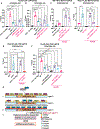RNA quality control factors nucleate Clr4/SUV39H and trigger constitutive heterochromatin assembly
- PMID: 38815580
- PMCID: PMC11227895
- DOI: 10.1016/j.cell.2024.04.042
RNA quality control factors nucleate Clr4/SUV39H and trigger constitutive heterochromatin assembly
Abstract
In eukaryotes, the Suv39 family of proteins tri-methylate lysine 9 of histone H3 (H3K9me) to form constitutive heterochromatin. However, how Suv39 proteins are nucleated at heterochromatin is not fully described. In the fission yeast, current models posit that Argonaute1-associated small RNAs (sRNAs) nucleate the sole H3K9 methyltransferase, Clr4/SUV39H, to centromeres. Here, we show that in the absence of all sRNAs and H3K9me, the Mtl1 and Red1 core (MTREC)/PAXT complex nucleates Clr4/SUV39H at a heterochromatic long noncoding RNA (lncRNA) at which the two H3K9 deacetylases, Sir2 and Clr3, also accumulate by distinct mechanisms. Iterative cycles of H3K9 deacetylation and methylation spread Clr4/SUV39H from the nucleation center in an sRNA-independent manner, generating a basal H3K9me state. This is acted upon by the RNAi machinery to augment and amplify the Clr4/H3K9me signal at centromeres to establish heterochromatin. Overall, our data reveal that lncRNAs and RNA quality control factors can nucleate heterochromatin and function as epigenetic silencers in eukaryotes.
Keywords: Clr3; Clr4/SUV39H; H3K9 deacetylation and methylation; MTREC/NURS; Mtl1; Sir2; de novo heterochromatin formation; heterochromatin nucleation; long noncoding RNAs; nuclear exosome.
Copyright © 2024 The Authors. Published by Elsevier Inc. All rights reserved.
Conflict of interest statement
Declaration of interests M.M. and J.S.K. have a pending US provisional patent application related to the data from this paper.
Figures







References
-
- Rea S, Eisenhaber F, O’Carroll D, Strahl BD, Sun ZW, Schmid M, Opravil S, Mechtler K, Ponting CP, Allis CD, and Jenuwein T (2000). Regulation of chromatin structure by site-specific histone H3 methyltransferases. Nature 406, 593–599. - PubMed
-
- Bannister AJ, Zegerman P, Partridge JF, Miska EA, Thomas JO, Allshire RC, and Kouzarides T (2001). Selective recognition of methylated lysine 9 on histone H3 by the HP1 chromo domain. Nature 410, 120–124. - PubMed
-
- Moazed D, Rudner AD, Huang J, Hoppe GJ, and Tanny JC (2004). A model for step-wise assembly of heterochromatin in yeast. Novartis Found Symp 259, 48–56; discussion 56–62, 163–169. - PubMed
MeSH terms
Substances
Grants and funding
LinkOut - more resources
Full Text Sources

